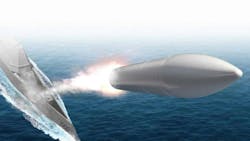Lockheed Martin moves forward to develop hypersonic missiles for U.S. Navy submarines and surface warships
WASHINGTON – The U.S. Navy is moving forward with developing hypersonic cruise missiles for deployment aboard surface warships and submarines to attack enemy valuable mobile targets.
Officials of the Navy Strategic Systems Programs office in Washington announced a $534 million order late last month to the Lockheed Martin Space segment in Littleton, Colo., for systems engineering and testing for Conventional Prompt Strike (CPS) hypersonic missiles.
CPS is a conventional boost-glide hypersonic missile with a two stage solid rocket motor, a hypersonic glide body, and kinetic-energy warhead. A hypersonic projectile travels at speeds of at least five times the speed of sound, or about 3,800 miles per hour. The Lockheed Martin Space is the CPS prime systems integrator.
A hypersonic missile traveling at Mach 5 or faster doesn't need an explosive warhead; its kinetic energy alone is sufficient to destroy or disable nearly any target it hits.
Military leaders say they plan to launch CPS from Zumwalt-class destroyers and Virginia-class attack submarines to strike valuable mobile targets. First deployment of the CPS is scheduled for as early as 2028 aboard Virginia-class attack submarines.
The Navy also provides the missiles and weapons control system for the Army’s Dark Eagle Long-Range Hypersonic Weapon (LRHW). The Army is integrating missiles and weapons control into a prototype LRHW battery operations center and launcher.
On this order Lockheed Martin will do the work in Denver; Sunnyvale, Calif.; Cambridge and Pittsfield, Mass.; Huntsville, Ala; Magna, Utah; East Aurora, N.Y.; Bristol, Pa.; Simsbury, Conn.; and other locations, and should be finished by June 2025.
For more information contract Lockheed Martin Space online at www.lockheedmartin.com/en-us/capabilities/hypersonics.html, or the Navy Strategic Systems Programs office at www.ssp.navy.mil.
About the Author
John Keller
Editor-in-Chief
John Keller is the Editor-in-Chief, Military & Aerospace Electronics Magazine--provides extensive coverage and analysis of enabling electronics and optoelectronic technologies in military, space and commercial aviation applications. John has been a member of the Military & Aerospace Electronics staff since 1989 and chief editor since 1995.
